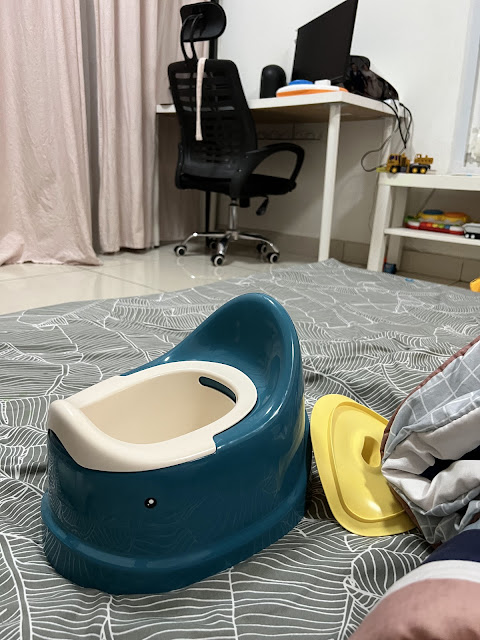Potty training is a big step for kids and their parents. The secret to success? Timing, patience, and lots of guidance.
Since I’m currently on a career break, I’ve been using this time to focus on potty training my son. My son is 5 years old this year and we first started talking about potty training when he turned 2 years old. I even bought him a baby toilet, thinking we’d start right away. But after trying a few times, it was clear he wasn’t ready. So, we took a step back and didn’t push him.
Still, every year, I would gently mention the idea of going to the toilet on his own. I didn’t force anything just planting the seed and checking in once in a while.
In February 2025, we decided to try again seriously. This time, he was showing some signs of readiness, and we made good progress. But just as things were going well, I had to undergo surgery unexpectedly, which paused everything. Understandably, the momentum we had was lost, but I reminded myself not to be discouraged. Life happens and so does potty training. 😅
Now that things are more stable, we’re back at it, and I want to share some practical tips from our journey that might help you too.
After my son turned 2, I started introducing simple bathroom terms like “pee” and “poop” during diaper changes or when I noticed him doing his business. I made it part of our daily conversations so he could learn the vocabulary. Most importantly, I avoided saying things like “dirty” or “yucky” when talking about stools it’s important kids don’t associate shame with normal bodily functions.
Even when my son didn’t seem interested or even cried when I brought up potty talk I stayed consistent. I kept talking about how one day he’ll use the toilet by himself. The key here is gentle reminders, not pressure. Kids remember more than we think.
Cartoons and books helped make the process fun and relatable. Seeing characters they like using the potty can motivate them. It helps them understand that it’s normal, not scary. Some of our favorites included “Daniel Tiger’s Potty Time” and a few simple YouTube animations.
Potty training isn’t about hitting a certain age, it’s about watching for signs of readiness. Ask yourself:
-
Does my child tell me when they’re about to pee or poop?
-
Can they walk to the bathroom and sit on a potty?
-
Can they pull their pants up and down?
-
Are they staying dry for 2 hours or more?
-
Do they understand simple instructions?
-
Do they show interest in copying adult behavior?
If you answered “yes” to most of these, your child might be ready! If not, that’s totally okay. Just keep introducing the idea gently and try again later.
Once your child is doing well with potty time during the day, try to stop using diapers. Transition to training pants or pull-ups first. Once they’re able to go a full day without accidents, you can start using regular underwear.
Let your child choose their underwear this gives them a sense of ownership and motivation.
If your child regresses or suddenly refuses to use the potty, it’s okay to take a break. Forcing it can lead to resistance or anxiety. Go back to diapers for a while and reintroduce the potty later. Use positive reinforcement like sticker charts, extra playtime, or reading a favorite book after a successful potty trip.
Once they’re comfortable, slowly introduce the regular toilet using a seat reducer and step stool.
7. Nighttime Training Takes Longer
Staying dry at night is a whole different journey. Most kids stay dry at night between ages 5 and 7. In the meantime, use disposable training pants and mattress covers during sleep. Celebrate small wins like waking up dry a few days in a row.
Accidents are part of learning. Stay calm and don’t punish or shame your child. Just clean up together and gently encourage them to try again next time. You can say something like:
“Oops, that’s okay. Next time, we’ll get to the potty a little quicker!”
Keep extra clothes in your bag when going out or at school, just in case.
One of the best purchases we made was a child-friendly toilet seat that fits securely on our regular toilet. It helped my son feel more confident and independent when transitioning from the potty chair. It was also easier for me to clean!
We got one with:
-
A soft cushioned seat
-
Side handles for support
-
A non-slip base
-
A matching step stool
👉 Here’s the one we use and love: https://vt.tiktok.com/ZSk3FwH9f/
Trust me, having the right toilet seat really made a difference in our journey. It gave him the sense of being a “big kid,” and it made the toilet less intimidating.
Potty training is not a one-size-fits-all process. Every child is different, and it’s okay to take your time. What matters most is that your child feels safe, supported, and encouraged.
I’m still on this journey with my son, and every day is different but I’ve learned that patience, consistency, and love go a long way. If you're in the potty training season too, just know: you’re doing great, mama/papa. You've got this!














0 comments